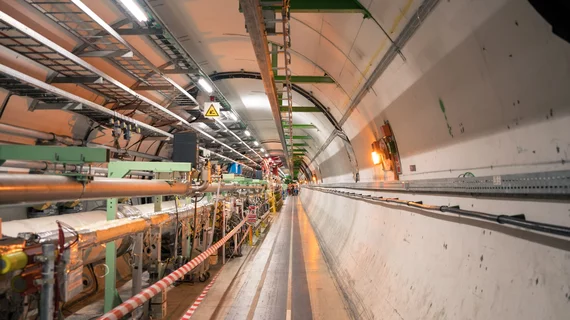At the site of the ‘God particle,’ explorers advance along a new frontier in medical imaging
A year after the FDA greenlit what it called the “first major imaging device advancement for computed tomography in nearly a decade,” the European Organization for Nuclear Research (CERN) drew more than 100 imaging professionals to discuss the breakthrough technology’s next medical applications.
The event was the sixth Workshop on Medical Applications of Spectroscopic X-ray Detectors, which wrapped Sept. 1 at CERN’s massive laboratory outside Geneva on the France-Switzerland border.
The anniversary it marked was last September’s FDA approval of a Siemens photon-counting scanner that deploys the detectors.
Radiologist Dushyant Sahani, MD, delivered the keynote address.
“The CERN workshops have been instrumental in advancing this technology and bringing it from the lab to the clinic,” Sahani told attendees, according to internal coverage by CERN, which is best known for operating the Large Hadron Collider used to find the Higgs boson, aka the “God particle.”
“Spectroscopic X-ray imaging is set to revolutionize diagnostic medical imaging by providing better images with a lower dose to the patient, allowing new workflows that optimize precious hospital resources,” added Sahani, who chairs the radiology department at the University of Washington in Seattle.
‘Better, Clearer Images at Optimized Doses’
Along with radiologists, CERN reports, participants included clinicians, medical physicists and biologists, along with developers of imaging equipment, detectors, contrast media and application-specific integrated circuits.
Noting that spectroscopic radiography builds on dual-energy CT technology, CERN points out that DECT requires two images and pre-scan planning.
Meanwhile the emerging photon-counting technique needs just one image, and the decision to use it can be made with the patient in the suite.
Moreover, in conventional X-ray detectors, the image taken is “based on the total X-ray energy absorbed by each pixel, forming a kind of black and white image,” CERN continues. “When spectroscopic detectors are used, the images also contain the ‘colors’ of the incoming X-rays, providing better, clearer images at optimized doses with significant benefits when diagnosing disease.”
A Vibrant Community of Specialists Convinced of the Technology’s Potential
More from CERN:
In some circumstances, MRI may even become superfluous. In other cases, where metal contrast agents attached to biomarkers are injected into the body, expensive PET/CT scans, may be avoided.”
CERN’s coverage also quotes Michael Campbell, a spokesperson for the organization’s Medipix collaboration.
“Eleven years ago, there was a lot of skepticism about the technical feasibility and the clinical benefits of spectroscopic X-ray imaging,” Campbell said before lauding the present and preceding CERN workshops for “crystallizing the ideas and forming a vibrant community of specialists who were convinced of the potential of the technology.”
Full story from CERN here.

